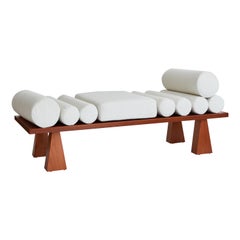Lennon Daybed
2010s American Modern Daybeds
Bouclé, Oak
People Also Browsed
21st Century and Contemporary Japanese Mid-Century Modern Table Lamps
Metal
21st Century and Contemporary Czech Modern Barware
Glass
21st Century and Contemporary Italian Modern Floor Lamps
Aluminum
2010s Italian Modern Table Lamps
Brass
21st Century and Contemporary Italian Modern Chandeliers and Pendants
Brass
21st Century and Contemporary Italian Coffee and Cocktail Tables
Glass, Art Glass
21st Century and Contemporary Portuguese Art Deco Chandeliers and Pendants
Metal
21st Century and Contemporary Portuguese Stools
Cotton, Wood
Mid-20th Century American Hollywood Regency Chandeliers and Pendants
Brass
21st Century and Contemporary Colombian Organic Modern Chaise Longues
Leather, Rattan, Wood
2010s Argentine Modern Decorative Boxes
Stone, Onyx
21st Century and Contemporary Italian Modern Coffee and Cocktail Tables
Blown Glass
21st Century and Contemporary Italian Mid-Century Modern Wall Mirrors
Alabaster, Brass
2010s South African Modern Sideboards
Steel
Vintage 1970s Swiss Mid-Century Modern Sofas
Leather
Vintage 1980s American Post-Modern Chaise Longues
Bouclé, Upholstery
A Close Look at Modern Furniture
The late 19th and early 20th centuries saw sweeping social change and major scientific advances — both of which contributed to a new aesthetic: modernism. Rejecting the rigidity of Victorian artistic conventions, modernists sought a new means of expression. References to the natural world and ornate classical embellishments gave way to the sleek simplicity of the Machine Age. Architect Philip Johnson characterized the hallmarks of modernism as “machine-like simplicity, smoothness or surface [and] avoidance of ornament.”
Early practitioners of modernist design include the De Stijl (“The Style”) group, founded in the Netherlands in 1917, and the Bauhaus School, founded two years later in Germany.
Followers of both groups produced sleek, spare designs — many of which became icons of daily life in the 20th century. The modernists rejected both natural and historical references and relied primarily on industrial materials such as metal, glass, plywood, and, later, plastics. While Bauhaus principals Marcel Breuer and Ludwig Mies van der Rohe created furniture from mass-produced, chrome-plated steel, American visionaries like Charles and Ray Eames worked in materials as novel as molded plywood and fiberglass. Today, Breuer’s Wassily chair, Mies van der Rohe’s Barcelona chair — crafted with his romantic partner, designer Lilly Reich — and the Eames lounge chair are emblems of progressive design and vintage originals are prized cornerstones of collections.
It’s difficult to overstate the influence that modernism continues to wield over designers and architects — and equally difficult to overstate how revolutionary it was when it first appeared a century ago. But because modernist furniture designs are so simple, they can blend in seamlessly with just about any type of décor. Don’t overlook them.
Materials: Boucle Furniture
As the weather grows colder, our minds turn toward nesting and all things soft and cozy. In the wintry months especially, bouclé armchairs, sofas, lounge chairs and other bouclé furniture bring warmth and comfort to our spaces.
This soft fabric is characterized by an irregular pattern of looped threads that yield its rich texture and volume. The yarn from which bouclé fabric is made — the name is French for “buckled” or “curled” and refers to the yarn and the fabric — is made up of twisted fibers. It has been used in furniture to reproduce the look and coarse feel of traditional handwoven textiles since the 1800s. But it was architect and designer Eero Saarinen’s revered Womb chair, crafted for Knoll in the 1940s, that turned this cozy but breathable fabric into a staple of modern furniture design.
Bouclé fabric can be found in mid-century modern, Scandinavian modern and Hollywood Regency furniture styles on 1stDibs, and a range of designers and firms including Pierre Paulin, Christian Sorensen, Fritz Hansen — and, of course, Knoll — have produced covetable bouclé furnishings over the years.
Given that Florence Knoll — a revolutionary modernist designer and former protégé of Eero Saarinen's father, Eliel, at Cranbrook Academy of Art — hoped for "something I could curl up in" when she requested what would become the famous Womb chair (and series), could it have been upholstered in anything other than her company's trademark "Classic Bouclé"?
Find antique, new and vintage bouclé furniture on 1stDibs today.
Finding the Right Day-beds for You
An antique or vintage daybed is a practical solution for furnishing any modest-sized bedroom or guest room and can even be a versatile option for the reading nook in your living room.
Daybeds, which traditionally comprise a simple three-sided frame and twin-size mattress or boxy foam cushion, have a long history that dates back at least to the early Greeks and Romans. The spare construction and multipurpose nature of these multifunctional marvels — they’re not loveseats, sofas or chaise longues, but each share some commonalities — have over time rendered them an easy and often essential piece of seating.
All manner of daybeds have materialized over the years. There are ornate, unconventional versions created in the Louis XV, Art Deco and Empire styles, while popular mid-century modern iterations include the Barcelona daybed, designed by Ludwig Mies van der Rohe and Lilly Reich, as well as the Nelson daybed, which architect George Nelson created for Herman Miller in the 1940s. But you don’t have to limit yourself to one of the classics.
Variations on the daybed have been developed all over the world, and contemporary examples come in all shapes, upholstery options and sizes. (They’re no longer limited to twin size.) No matter what style you choose, this luxury furnishing ensures that you don’t have to wait until nighttime to start dreaming.
On 1stDibs, find a cozy collection of antique, new and vintage daybeds today.
